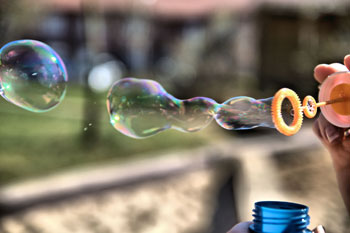Blowing bubbles for science
For perfect bubbles, air speed is more important than the thickness of a soap film

Scientists have fleshed out the physics of blowing soap bubbles. Air speed really matters, they find.
JEDIDJA/PIXABAY
There’s a science behind the art of blowing soap bubbles. It’s not the thickness of the soapy film that matters. Rather, the speed of the blowing gust of air determines whether bubbles will emerge, scientists now report.
“We have all blown soap bubbles,” says study coauthor Laurent Courbin. He is a physicist at the University of Rennes in France. “It’s nice to be able to explain simple experiments that we have all experienced in our lives.”

Courbin and his colleagues looked through centuries of studies for ones on the physics of bubble blowing. They couldn’t find any. So the team built a device that is something like the cousin to a bubble wand. It pumps a controlled, even layer of bubble liquid over an opening that is roughly 1 meter (1 yard) high. It’s width is adjustable. The scientists peppered their device with pressurized jets of air. Quick gusts of that air pushed out bubbles. Slow-moving jets only dimpled the film.
To explain this, the scientists came up with a set of mathematical expressions called equations. They predict this minimum speed cutoff under different conditions. The equation needed to find this speed can vary — for example, when the gas nozzle is placed right against the bubble layer. And it is different when a gust is wider than the film itself. (Testing the last condition required the use of smaller, circular bubble wands.)
Several things determined how fast a gas jet had to travel to make a bubble, the scientists showed. These included the density of the gas being blown, the width of the soapy film and how far a gas-blowing nozzle was from the film. Also important: the size of the air nozzle.
The researchers blew bubbles of increasing size. They started with tubes smaller than a millimeter (0.04 inch) across and went up to wind tunnels as big as 20 centimeters (8 inches) wide. For most experiments, the minimum speed needed to blow a bubble ranged from 10 meters per second (22 miles per hour) to 100 meters per second.
The findings appear in the February 19 Physical Review Letters.
The study provides a nice illustration of physics principles, says Howard Stone. He studies a field of science known as fluid mechanics at Princeton University in New Jersey. Courbin’s team explored the science of physical interfaces, he notes. “But they took the motivation from something you have in a science museum, or even a children’s museum,” he points out.
Now that the bubble basics have been explained, future studies could test different fluids, Courbin says. The results might help inform other research. One example: making foams that use bubbles as building blocks. But bubbles have inherent value on their own as study subjects. “They are useful for education, for practical reasons,” Courbin says, “and for fun, too.”
L. SALKIN ET AL/PHYSICAL REVIEW LETTERS 2016
Power Words
(for more about Power Words, click here)
density A measure how condensed an object is, found by dividing the mass by the volume.
equation In mathematics, the statement that two quantities are equal. In geometry, equations are often used to determine the shape of a curve or surface.
fluid mechanics The study of the properties of fluids (liquids and gases) and their reactions to the forces acting upon them under various conditions.
physics The scientific study of the nature and properties of matter and energy. Classical physics is an explanation of the nature and properties of matter and energy that relies on descriptions such as Newton’s laws of motion. Quantum physics, a field of study which emerged later, is a more accurate way of explaining the motions and behavior of matter. A scientist who works in that field is known as a physicist.







